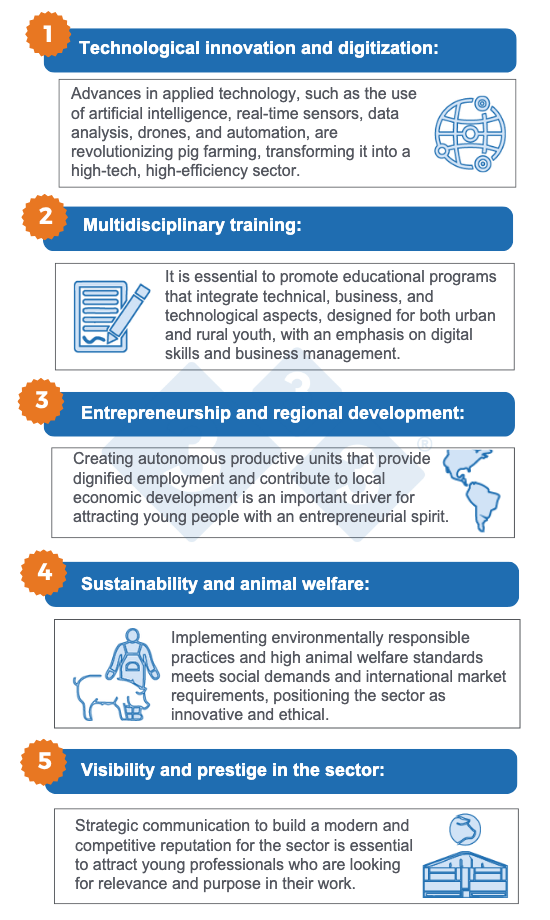We know that young people in the new generation don't just want to work; they want to create an identity for themselves and want to feel that what they do leaves a mark, that they are investing their time in something meaningful, and that their occupation has to do with their interests, skills, and values.
Opportunities globally and in Latin America
The swine industry is undergoing a period of expansion and transformation. According to recent data, global growth of more than 7% is expected over the next 10 years, both in pork production and consumption. Estimates suggest that global production will reach 131.1 million tons in 2033, and consumption will increase in all regions except Europe, although it will remain the most consumed meat in the region. Projections indicate that Asia and Latin America will be the regions with the highest growth (Castro, 2024, with data from OECD-FAO, 2024).

Latin America, in particular, has maintained steady growth in pork production, with countries such as Mexico, Brazil, Argentina, Colombia, and Chile leading the regional ranking. By 2025, growth of around 2.5% is projected, driven by domestic demand and the reconfiguration of trade flows with increasing regional exports (Castro, 2025).
This dynamic creates multiple opportunities in production, marketing, logistics, technological innovation, and related services, opening up space for the development of young talent in different areas.
What challenges does the agri-food sector face in attracting young people?
The global agri-food sector is undergoing a profound change in its labor structure. The aging of the rural population continues to be one of the most recurrent phenomena in the world. According to the FAO, by 2030, the rural population aged 65 and over will increase, reaching 71% in Latin America (Zabala & Knobloch, 2021). This undoubtedly poses a challenge for generational succession in the sector and raises the need to design inclusive strategies that attract young people with different backgrounds and experiences.
Technological advances and digitization offer an opportunity to reverse this situation by transforming agri-food activity into a highly innovative field with the potential to offer skilled jobs that are attractive to young people seeking professional development, autonomy, and a positive social impact (FAO, 2017).
Despite its growth, the pig farming sector is no stranger to difficulties in attracting and retaining young talent. The main barriers include the traditional perception of the sector as manual and rural work, the lack of visibility of professional opportunities, and the disconnect with new technological and market trends in some regions.
In Latin America, these limitations are reflected in the low number of young people entering technical and professional careers related to pig farming, which jeopardizes generational succession and the sector's sustainability.
Strategies to make pig farming an attractive sector for young people

Pig farming has become a strategic platform for young people from diverse backgrounds to develop, innovate, and make a real impact on their communities and regional and global economies. This requires a comprehensive vision and human resources prepared to face challenges with passion, knowledge, creativity, leadership, and responsibility.



